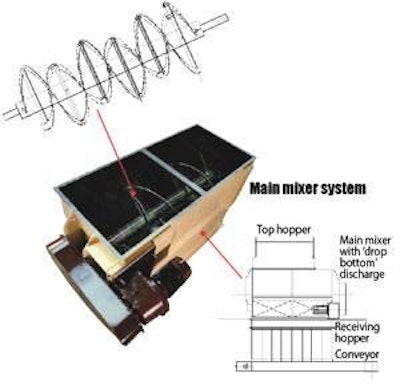
People are right when they say the mixer is the 'heart' of the feed mill. It is the first 'organ' in the feed manufacturing system where the various components of a diet come together. Its operation dictates both the volume and the quality of the plant's output. Like any heart, the mixer deserves a regular check on its health, to make sure it is functioning reliably and efficiently.
No physician could monitor the health of an organ without first understanding its structure. Many machines are described as mixers and used for specific mix-and-blend applications in both industrial and on-farm situations. What is more, feed plants over the years have adopted various mixer designs. Today, however, the horizontal batch type is employed almost universally for the main duty of mixing complete compound rations to feed farm animals. So the following remarks refer to a horizontal batch mixer, differing from one site to another in matters of detail.
Heart of the mill: Horizontal batch mixer
The horizontal batch mixer may be fitted with a ribbon-blade shaft or a paddle-blade assembly, depending on preference. Occasionally, there are supplementary mixers in the line, most typically a continuous mixer for adding liquids to the mixed meal and a high-speed paddle type for adding liquids and micro ingredients to the finished pellets.
As a general rule, the main machine is installed to form part of a three-tier system in which materials flow by gravity. In addition to the mixer, this comprises two hoppers. The top or surge' hopper, upstream from the mixer, collects the majority of ingredients to be mixed and has a rapid discharge gate, while the other is a receiving hopper, downstream from the mixer, to accept the mixed meal prior to distribution to the rest of the plant (see figure).
One of the most popular types of mixers now in use is a single-shaft unit that has an inner and outer ribbon blade, giving a counter-flow action to achieve the best mixing efficiency within an optimum time of 4 minutes (see figure). Allowing for filling and emptying, a cycle time or period of 6 minutes can be achieved with such a mixer. The resulting nominal plant capacity would be 10 tonnes per hour from a 1-tonne mixer, 20 tonnes per hour from a 2-tonne mixer, and so on.
The twin-shaft, paddle-blade mixer represents a further development in main mixer design. Generally manufactured in stainless steel for cleanliness, it features a short mixing time to avoid product damage and typically can be used where liquids and micro ingredients are added to finished pellets. Twin-shaft machines most often operate on a batch mixing system, which means the main product must be weighed in and either weighing or metering of the additives is also required. Accurate inclusion rates are achieved and emptying through rapid discharge gates results in a quick and residue-free transfer of product. These mixers also help when the mixing process must minimise attrition or physical degradation, as in the case of processing flaked or other easily-broken materials.
In theory the development of rapid discharge gates on the mixer's top hopper, and development of high-speed, paddle-bladed mixers, should reduce mixer cycle times. Practically speaking, however, no reduction in cycle times can be obtained unless the system to feed material into the mixer and transport meal away from it has the requisite size and speed.
Preference for volume measure
Any mixer health check first focuses on capacity: Does the mixer's size comply with the plant's requirements? When specifying the size of mixers in feed milling, it is generally assumed that the product to be mixed has a density or specific gravity of 0.5 or 50% of water. Although that converts to 504.6 kilograms per cubic metre on the metric scale or to 31.5 lb per cubic foot in imperial units, it is considered good practice to quote capacities in volumetric terms such as litres in order to avoid misunderstandings.
It therefore follows that a 2000-litre mixer can handle 1000 kilograms at the 0.5 density and is referred to commonly as a 1-tonne machine. However, the volumetric rating itself is important. Particular attention should be paid when mixing either a high proportion of minerals or low-density materials such as ‘wheatfeed' or ‘wheat midds', whole cottonseed, and others. The volume tolerance of the modern mixer is fairly liberal, but a reasonable number of mixing errors can be attributed to incorrect filling rather than to faults in machinery design.
Mixers are not designed for starting under load or for over-filling. The most common example of the consequences involves either a malfunction of the discharge gate or a failure to empty the lower hopper. The result, known as ‘double-dumping', is the release of a second batch from the top hopper into the mixer before the first batch has been discharged. The additional load on the mixer's motor can cause it to stall. Depending on the mixer discharge design, a stall condition means the mixer may have to be cleared manually.
Bending or even breakage of the ribbons or other mixing tools are other possibilities, together with distortion of the discharge gate mechanism. While such effects might not stop the mixer, they would certainly impair the mixing efficiency and may cause contamination between batches. Any problems may not become apparent until a product analysis is carried outin other words after a significant tonnage has been produced. Safeguards in the control system to prevent such occurrences are therefore essential. Mostly they take the form of level indicators and micro-switches to provide feedback to the system controlling the batching sequence.
In current practice, the most usual first stage of mix-and-blend routines is the weighing of the various ingredients deemed necessary for the animal by the nutritionist. The second step sees these raw materials going through the grinder before any micro ingredients are added to them at the mixer, although an alternative sequence grinds and stores the materials prior to weighing them to make up the required batch. When the mixing cycle is completed, the mixed meal is either pelleted, stored, or bagged off in its finished form.
Critical check points
Feeds are mixed in order to give them a uniform consistency, so all parts of the mixed product should be the same within a measurable tolerance or co-efficient of variation, in order to produce the same results in animal performance. A feed that is not mixed satisfactorily can be extremely variable in consistency, with pronounced pockets or layers of different materials, and can be predicted to have a detrimental effect on the animal.
Anyone who has managed a mill will know that achieving this essential mix is often difficult in practice with a compound animal feed. Most difficulties are due to the fact that the physical characteristics of the different ingredients can vary considerably. To obtain near-perfect results when mixing dry particles together, they should be free-flowing and share similar properties of size, density, moisture, and shape. Unfortunately, a typical feed mix tends to be the exact opposite of this ideal! It is likely to contain a broad spectrum of particles because of the inclusion of such widely differing products as mineral additives, wheatfeed, or bran and high-protein ingredients.
A partial solution towards reducing these extremes is to use a ready-made or proprietary premix, particularly where important ingredients are to be included at a low rate. Whether they are vitamins, trace minerals, or other micro ingredients, the premix brings them on a carrier base to obtain good dispersion in the final mix. The premix is reasonably homogeneous and can be added in normal inclusion levels to the main mixer. This approach helps to minimise ‘manual tipping' or bag dumping and improve the accuracy of the final product.
Cross-contamination: Leakage and residue
How to avoid cross-contamination in the main mixer can be a vexed and highly topical question. Most horizontal mixers are now being supplied with rapid discharge gates covering the full-length of the mixer bottom. Known as ‘drop-bottom' or ‘bomb door' discharge gates, this discharge design virtually eliminates any residue in the mixer body, addressing the increasing concern over cross-contamination and the necessity to achieve a complete clear-out of the mixer between batches so that the ingredient balance is maintained. The check point for mill managers to bear in mind is the integrity of the sealing between these gates and the main body of the mixer. A good seal is vitally important to ensure that an alternative source of contamination is not introduced.
In fact, appearances are deceptive if it seems that a mixer fitted with slide gates or ‘slides' is more likely to lead to cross-contamination, due to residue either between the ribbons and the body or in the pockets of the slides. Micro ingredients introduced after the mixer has been filled with macro ingredients are thoroughly mixed into the batch. Accordingly, the relative percentage of any additives present in the material that may remain in the mixer is extremely low.
Special attention to liquids application
Still, with the aim of minimising possible points of contamination, the accepted practice is to add the concentrates to the rapid discharge hopper and the micro ingredients directly to the mixer. Liquids, such as fat, can also be added at this point directly into the mixer to good effect. To obtain the best fats dispersion, application should be at a high temperature and effected as quickly as possible to allow full mixing before the fat has cooled.
However, the addition of liquids must be made when all the dry materials are already in the mixer and have first received a dry mixing. Particular attention should be paid to the positioning of the point of entry of liquids. Liquids sticking to the shaft assembly would impair the mixing action and their collection in the discharge assembly or slides could cause leakage.
An alternative place for adding liquids is downstream from the main mixer in the continuous mixer or liquids blender. Such machines can have a capacity of up to 100 tonnes per hour, with the ability of blending up to four liquids at inclusion rates up to 35-40%. They comprise a tubular body with a plastic liner to minimise adhesion and wear. Mixing is done by a shaft, running at high speed and fitted with paddles angled to achieve both blending and conveying. A weir plate may be fitted to reduce the speed of material through the mixer, while rotary breakers can also be placed at the outlet to eliminate any lumps.
The downsides of downstream liquids application in a continuous mixer or liquids blender are power demands and maintenance. A continuous mixer may need as much as 45-55 kw of power, and wear on the paddles tends to be fairly high. An in-line weighing device can be used to monitor the dry material and regulate the liquids flow, to achieve the desired inclusion rate.
These remarks set the scene to consider mixer tests to establish efficiency of mixing, which will be covered by an upcoming article. However, testing remains is just one of a series of health checks for proper feed mixing. Remember that a main mixer is likely to be one of the longest-serving machines in a feed mill's equipment inventory. No machine however robust its constructioncan survive constant use without being maintained regularly and monitored at every opportunity.















